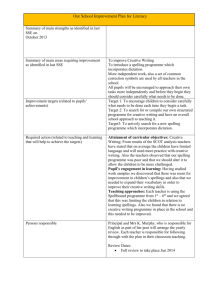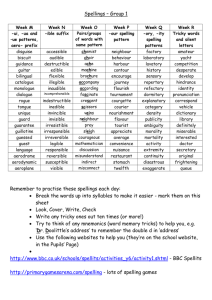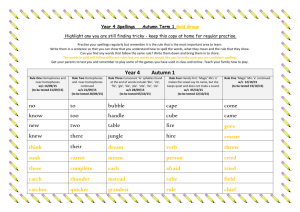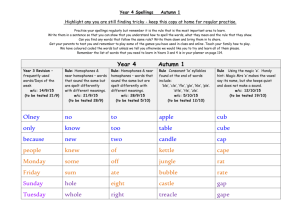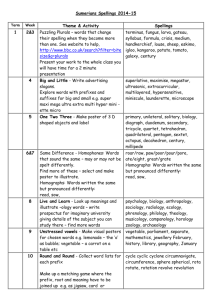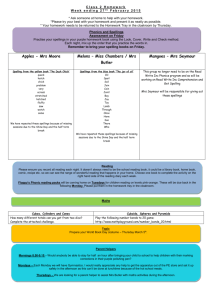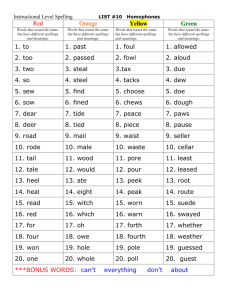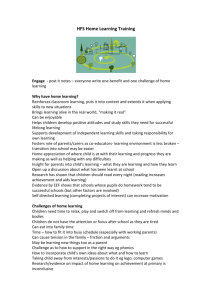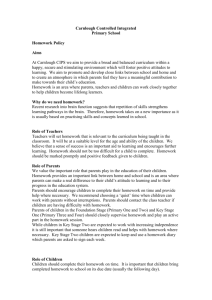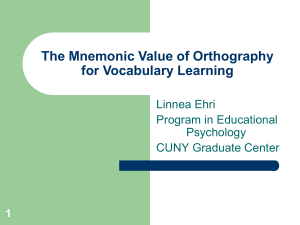Helping your dyslexic child with spelling
advertisement
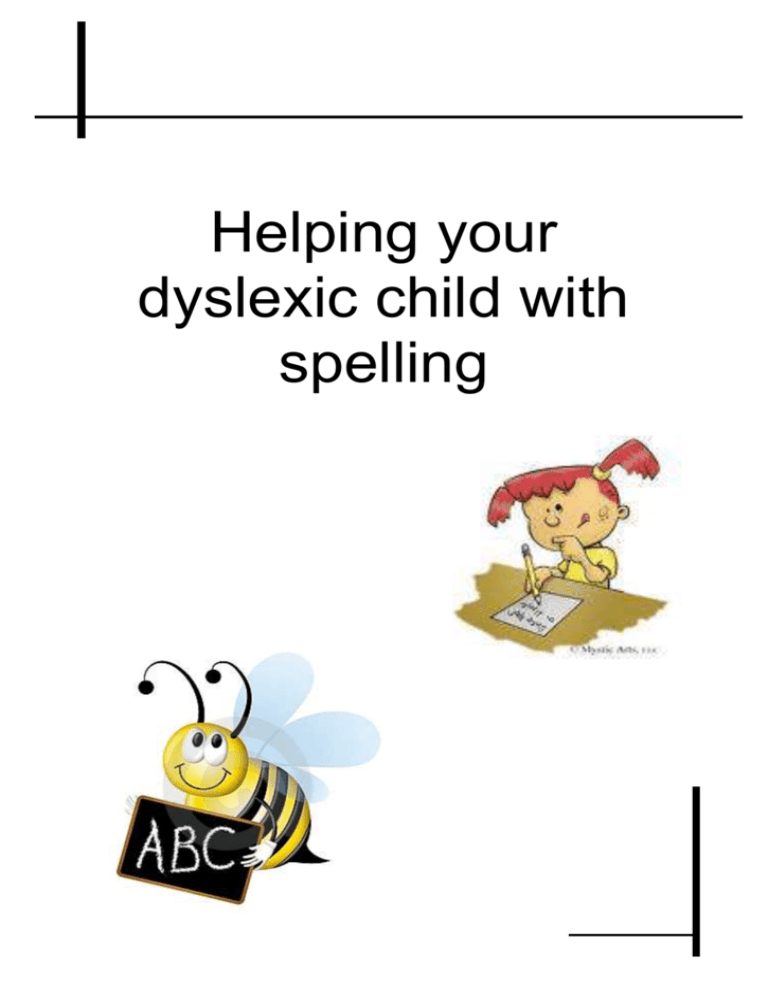
Helping your dyslexic child with spelling Learning to spell can be extremely difficult for dyslexic children. Time, patience and practice can help tremendously! There are many ways to practise spellings but what works for one child may not work for another. For most people a multi-sensory method works best – using as many senses as possible like eyes, ears, voice and hands. Many children rely on one strategy to learn their weekly spellings as a list and use them in their own writing. Some children learn effectively in this way but for many children one way of learning is not effective because they either memorise words for the actual test and then forget them later or they struggle to learn the words in the first place. If you consider what type of learning style your child has, then you could use some of the suggested activities to help your child learn their spellings through their stronger learning style. Look at the following pages and see if you recognise the learning style of your child. Auditory learners: Learn by listening and remember what has been said, rather than what they have seen. Talk to themselves while working. Are easily distracted by noise. Find writing difficult, but are better at telling. Move their lips and pronounce words as they read. Enjoy reading aloud and listening. Are talkative, enjoy discussions and describe things at length. Are able to spell out loud better than writing. Visual learners: Speak quickly. Are neat and orderly. Are good long range planners. Spell well and are able to see words in their minds. Remember what they have seen, rather than heard. Are not distracted by noise. May forget verbal instructions unless written down. Are strong, fast readers. Would rather read than be read to. Doodle during conversations. Forget to relay verbal messages to others. Kinaesthetic learners: Learning by manipulating and doing. Want to act things out. Speak slowly. Touch people to get their attention. Stand close when talking to someone. Can’t sit still for long periods, move about and gesture a lot. Memorise by walking and seeing. Can’t remember geography unless they’ve actually been there. Use action words. May have messy handwriting. Enjoy involved games. It is highly likely that the majority of children will show some aspects of more than one learning style. However, if you feel your child exhibits a particular learning style try the activities in that section. If no one style is apparent, try a few activities from each section and see which is most beneficial. Suggested Activities Auditory learners may prefer to learn by: Breaking words into parts. Singing spellings. Verbalising – or saying it strangely, e.g. father becomes fat-her. Recording their spellings onto tape. Using rhythm – tapping out spellings. You say it – they repeat it. Spelling words out as a “rap”. Visual learners may prefer to learn by: Looking at a word and noticing patterns. Highlighting the pattern. Say, or repeat, the word. Listen to the syllables. Copy or trace over the word. Cover the word and write it from memory. Check the word. Does it look right? Writing the word in the air – using a finger or a wand (or a sparkler!!). Writing the word on your back. Writing in large felt tip pens, using different colours. Finding little words in longer words. Kinaesthetic learners may prefer to learn by: Writing in a sand tray (sugar, rice or even salt can be used). Feeling you write the words on their back. Making words with pipe cleaners, plasticine or clay. Visualising letters as picture clues that link into a story. Mnemonics – make a silly sentence and illustrate it, e.g. SAID becomes Silly Ann Is Drinking. Use different colour pens to write the words. Video memory – act out a spelling mnemonic. Other things to consider: The use of software computer programmes to support and reinforce learning spellings. There is a wide variety available which make spelling practice fun and provide a high level of multi-sensory reinforcement. Some useful ones are: Word Shark Nessy Learning Programme Spelling Made Easy Available from www.thedyslexia shop.co.uk Make practice FUN! MAKE UP games: Make word searches (with words reading left to right only). Make spelling cards into jigsaws. Unscramble spellings – use a set of wooden or plastic letters. Use any board game to practise spellings. For example number spellings 1 to 6 on the back of cards. They have to spell a word from a card and if correct can move forward the number of spaces that is on the back. Hangman. Dominoes using beginnings and ends of spellings to match. Noughts and crosses – if they spell a targeted word they can place a nought or a cross. Fill in missing letters – write some targeted words omitting one or two letters. Ask your child to close their eyes and imagine the letters of the spelling in different colours. Can they spell the letters of the word out loud? Use a picture background that links the word. Draw a box around each letter and look for patterns and letters that are tall or that hang below the line. Can your child remember what goes in each box? Whatever you choose to do, learning spellings can seem a boring process when it needs so much effort from a child. Try to make it as much FUN as possible by using a variety of materials and activities. CHANGE from pencil or pen to: Whiteboard and dry-wipe pen (laminate a piece of paper and use as a wipe on / wipe off surface). Chalk. Multi-coloured pens. Computer keyboard. USE to build words: Magnetic, plastic or wooden letters. Scrabble letter tiles. Playdoh, pipe-cleaners or plasticine to make letters. Sand or rice trays. Encourage practising in cursive handwriting as this helps automatic recall of spellings by encouraging kinaesthetic memory. Be as creative as you can in making up mnemonics with your child – the funnier the better. e.g. – ought becomes o u great hairy twit! - ight becomes I go home tonight. Try visit www.iamdyslexic.com for more ideas on mnemonics. Make up a list of SUCCESSES – “Words I CAN SPELL” to prove how many words your child does remember regularly.
